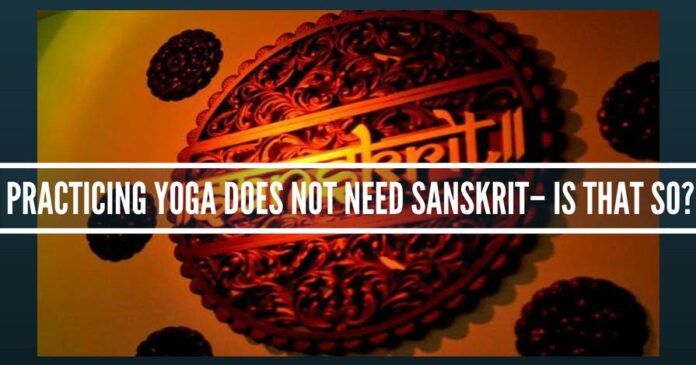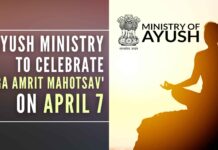
Samskritam should not be forced down the throat of each and everyone who wants to learn Yoga.
This is a response to the article that appeared last week in The Hindu titled “What’s in the name” by A.G.Mohan and Ganesh Mohan with the subtitle – “Practicing Yoga Does not need Sanskrit”.
A perusal of the article reveals that this is written in an incoherent manner and this article trivializes the role of Samskritam in the context of Yoga and misguides the seekers of Yoga.
I will not be using diacritics in the article so as to make it reader-friendly for the layman.
The authors should know that it is Samskritam and not Sanskrit. The very meaning of the term Samskritam is, “that which has been organized well”. Beginning with this, the sum and spirit of the article with utmost sincerity carry the message of the erstwhile western colonial masters.
Having said this about the article, to substantiate this, an analysis of the content of the article can be presented in five parts:
- The picture and the caption beneath it.
- Content under the two opening paragraphs
- The first paragraph under the subheading – Naming Asanas
- The remaining paragraphs under the heading – – Naming Asanas
- The Question – What if a practitioner has no religious beliefs? and the last paragraph that answers the question.
Now let us analyse this article point by point.
- The picture and the caption beneath it.
Along with the picture of Sri Krishnamacharya, there is a statement – “Practising yoga does not require a knowledge of Sanskrit.”
Should this be taken just an oversight or is there something else behind this?
When the article does not contain any statement or quote from Sri Krishnamacharya regarding the idea that Samskritam is not necessary for Yoga, then why has this been done?
Probably – it may be due to the fact that people these days browse topics and move on. Is this a design, then, to make even a casual browser, who would not read the entire article, get an impression that Sri Krishnamacharya himself has stated this about Samskritam in the context of Yoga?
Concentration and stillness of the mind are just by-products. Yoga is not just a psycho-physical disciplining
- Content under the two opening paragraphs
From the second section let us consider the article part by part. There are various statements under this section which need scrutiny.
Statement:
The primary goal of classical yoga is to bring concentration and stillness to the mind.
Reply:
The very opening statement is flawed. The ‘primary’ goal of classical yoga is the realization of the true conscious nature (purusha) of each and every individual by rendering the mind and its operations ineffective and finally non-existent so that it does not deflect or distract the true conscious nature of the Atman. (Refer sutras of Patanjali – 1.3, 4.34)
Had they stated that one of the goals of Yoga is concentration and stillness of the mind, it could be acceptable. But when they use the term ‘Primary’ their statement has to be criticized.
Concentration and stillness of the mind are just by-products. Yoga is not just a psycho-physical disciplining. It is not even an eastern or Indian substitute or counters part of western psychology. It is essentially spirituality. Knowledge and familiarity with Samskritam will bestow this clarity.
Statement:
Now let us consider the next set of sentences.
Practising the true aim of yoga — to calm and control the mind — does not require a knowledge of Sanskrit. Being familiar with many Sanskrit names, such as those for yoga postures does not, in and of itself, indicate that a person is practicing authentic yoga.
Reply:
The intentions of the author, in focusing on the spirit and not on the letter, which is welcome, could have been justified, had they begun with the statement that – for commencing the practice of Yoga, Samskritam is not essential.
Yes, it is accepted that for raising and dropping the arms and breathing practices one might not require Samskritam. But the intentions of the authors need questioning when they trivialize the role of Samskritam in the context of true aim of Yoga/Primary goal, about which the authors of the article themselves are not correct when seen in the light of what Patanjali has stated, which has been shown in the previous section.
Furthermore, coming to the section Knowledge of Sanskrit and (being) familiar with many Sanskrit names – Do the authors mean to say that neither knowledge or familiarity of Samskritam, in which almost all authentic texts of Yoga are penned including those of Sri T Krishnamacharya, is not required?
Yogavalli commentary on the Yogasutra by Sri Krishnamacharya, Yoganjalisaram, Dhyanmalika, Adiseshastakam – all these works of Sri Krishnamacharya are in Sanskrit. Not only are these texts repositories of invaluable knowledge of Yoga which lead us to the true aim of Yoga, but their chanting (except Yogavalli) is also considered a potent tool that ‘calms and controls the mind’ – the true aim of Yoga(?). Is chanting of the mantras not an important and unique tool of Yoga that Sri Krishnamacharya introduced to gain control over the breath and the mind?
Will the authors contradict this? If they do, then it would be like cutting the branch of tree on which they are sitting.
While the following bit of information is not mentioned in the article, it is of considerable interest that a simple google search of the authors reveals that they run an organization which ironically is named in Samskritam as Svastha Yoga. If the true aim of Yoga did not really require Samskritam why adopt a Sanskrit name for their organization?
Moreover, if one does not learn Samskritam to understand the true aim of Yoga, then what are the sources to understand the true aim of Yoga? If it is said that one can understand the true aim of Yoga through the following, then let us examine each proposition separately.
It may be argued that the True aim of Yoga can be learnt from someone who professes to know the language or claims to have inherited the knowledge, say a teacher, even without knowing Samskritam.
A)Translations in English and other languages, B) Depending on teachings and interpretations of the teachers.
A) Translations in English and other languages
We are all aware that translations are not free from the prejudices and limitations of the translator. There is even an expression in English “lost in translation”. Being aware of this, why would one knowingly resort to or recommend secondary content when the original is available. Even in the supermarkets, we do not do this. Unless there is genuine lack of choice, would we knowingly buy second quality material when the original is available?
When the authors speak about the aim of Yoga with the adjective “true”, it is assumed that they intended the ‘true aim of yoga’ to be understood only from the original source and not secondary ‘true aim’ understood from translations.
To this, a person could respond by stating that Samskritam is difficult to learn. It is a wrong perception. All languages other than the mother tongue need effort. Even English, that has been forced on us, is not easy. Even after studying English for the entire duration of schooling, college and university, how many Indians can speak English flawlessly and with confidence? Further, there is absolutely nothing that comes easily in the world. It is also well known that anything that comes easily is not durable or worthy. Even the practice of yoga is very challenging. Allotting time in one’s schedule and diligently following it with great motivation every day, is also not an easy job. So, these are to be considered as just lame excuses to hide one’s own laziness or prejudices in not learning Samskritam for Yoga.
B) Depending on interpretations of those who profess to know it all.
It may be argued that the True aim of Yoga can be learnt from someone who professes to know the language or claims to have inherited the knowledge, say a teacher, even without knowing Samskritam.
It is undeniable that one needs a teacher to guide an individual in the path of yoga. But it does not mean that one should totally abstain from studying. The yoga sutras themselves state svadhyaya as an important limb of Kriyayoga. We find svadhyaya being repeated as one of the niyamas as part of Ashtangayoga also.
What is the meaning of the term svadhyaya? svadhyaya means Japa of mantras like Om or study of texts that speak about liberation- according to a host of Yogasutra classical commentaries of Yogasutras beginning from Vyasa and its sub-commentaries, Bhavaganesha’s commentary and so on to the Yogasutra 2.1.
Moreover, it also implies total dependence on the other person for understanding Yoga. Dependence always leads to exploitation (and even disillusionment later). Whereas, in contrast, learning Samskritam is empowerment and freedom from exploitation. By trivializing the study of Samskritam in the context of Yoga, are the authors intending to herd unsuspecting people into hands of unscrupulous exploiters? (which sadly is already happening)
Statement:
The fundamentals of the practice of yoga came to us many centuries ago in the Sanskrit language. But the methods and benefits of the practice transcend language and culture.
Reply:
It is unclear what exactly is the intention of this two successive but disconnected statements. Do the authors mean to convey that the centuries-old texts in Samskritam only have the fundamentals of Yoga and do not have methods and benefits? If so, the logical question to their second assertion is to question where the methods and benefits that they ascribe to yoga come from. Or, do they mean to say that the methods, benefits and all practical details are developed only now?
This muddling of issues is in essence what disregard for Samskritam brings about. Yoga literature did not freeze with centuries-old Yogasutras that gave the “fundamentals”. So many commentaries and Sub-commentaries have been composed with uninterrupted continuity from 4th century CE till 20th century in Samskritam. It is a sad commentary on the state of affairs because no one reads Samskritam to unravel all the knowledge about the methods and benefits discussed therein. Instead, everyone is busy projecting their own (mis)understanding of the text. The arrogance of today’s “experts” is so high that they believe that whatever methods and benefits they interpret, are final for yoga. What audacious disrespect for millennia-old tradition!
- The first paragraph under the subheading – Naming Asanas
Statement
“We do not have to name each of the numerous variations of classical asanas, in Sanskrit or in any other language, to practise them.”
Reply:
Inexplicably, the focus shifts to the asana aspect of Yoga in this paragraph. So Yoga is limited only to asanas?
I am not saying that all the variations of any given asana be given a name. But using this to trivialize Samskritam is unacceptable.
Extending the argument that they gave for naming each and every variation of asana to all the asanas that have a nomenclature in Samskritam, we could argue that there is a case for not naming the asanas at all. The teacher could demonstrate and the students could simply follow. That way, one would even “transcend language”.
It is a plain common sense that, rather than describing the detailed procedure of the final posture of each Asana, the resemblance of the posture to a known entity in the form of a bird or animal or a noble character etc is given to capture the essence of the asana.
Moreover, perplexingly, in the later part of the article the authors themselves show with quotations from Sri Krishnamacharya, that Samskrita names of various asanas are not mere names, they carry with them various ennobling themes and associations, utilizing which the quality of the asana becomes sublimated.
Practicing Yoga Does not need Sanskrit, to say the least, is short-sighted and misguiding and senior practitioners of Yoga should reflect deeply before penning their thoughts on important issues like this.
- The remaining paragraphs under the heading – – Naming Asanas
The two paragraphs describe with quotations from Sri Krishnamacharya, the wonderful meaning of the terms Bhagirathasana and Virabhadrasana. This directly contradicts what has been stated in the previous paragraphs.
Would this then mean that the authors are making an honest admission here that “Sanskrit not needed for yoga” is their own view and not endorsed by Sri Krishnamacharya. If so, then the honesty of the authors should be lauded and the subtitle to the article which is seen with the picture of Sri Krishnamacharya should be shed.
But if it is not so, then, this shows poor logical reasoning on the part of the authors. One should supply evidence to support one’s assertions and not strongly refute one’s own claim in the same article!
Even in the midst of such a logical blooper, the authors should be congratulated for bringing to fore the views of Sri Krishnamacharya on Bhagirathasana and Virabhadrasana. How deeply ennobling these terms are! Can the translations in English for the same asanas – Tree pose and Warrior pose come anywhere close to the beauty that Sri. Krishnamacharya’s explanation gives? In fact, the exposition even inspires a reader to learn Samskritam.
- The Question – What if a practitioner has no religious beliefs? and the last paragraph that answers the question.
This seems to be one slightly sensible portion of the article. A staunch ‘atheist’ ex-chief minister of Tamilnadu practised Yogic ‘Sun Salutation’ by translating the Mantra into Tamil (ஞாயிறு போற்றுதும்). Irrespective of the language, even an atheist did salute the Sun. He not only understood that Sun Salutation (Suryanamaskara) is not religious and he did practise it.
In essence, the spirit of most practices in the Vedic Hindu religion, the mother of Yoga, is promoting life in harmony with nature and fellow beings. If that is understood, this question of belief and non-belief will not at all arise.
Conclusion
In India, if someone were to say “In the process of mastering science there is no need of English” imagine the responses and ridicule one would face?
Independent India has very few people pursuing science in their mother tongue. This is so only because the governments of the day have not been serious or encouraged the use of indigenous languages in the field of science. Hence sciences are still taught in English.
Advocating the study of Samskritam in the context of Yoga is not due to resistance to overcome colonial hangover like in the case of English. The elevating vibrational value of the language, its perfect grammatical structure (that is why it is called as Samskritam – perfected language) that offers many shades of meanings, words that are packed with connotations and contexts with many layers of wisdom accumulated over a few thousand years, are the reasons for which one should pursue Samskritam in the context of Yoga. Should we all miss out on these aspects by reading some translations?
Hence the statement “Practicing Yoga Does not need Sanskrit”, to say the least, is short-sighted and misguiding and senior practitioners of Yoga should reflect deeply before penning their thoughts on important issues like this.
Finally, Samskritam should not be forced down the throat of each and everyone who wants to learn Yoga. However, prejudice or bias should not be created against Samskritam. Gradually, teaching methods should be evolved (some efforts have already begun in the direction, where the author of this response article is also playing a part) in the field of Yoga that is Samskrita friendly, for the benefit of the practitioner to guide him towards the true aim of yoga.
- “Practicing Yoga Does not need Sanskrit” – Is that so? - May 11, 2018











I am a Canadian yoga instructor who has been leaning Vedic chanting with for the last 5 years and my understanding of Yog has deepened beyond any of my expectations. I get criticized from time from students but this is my dharma and I follow it.
I know Samskrit and have attended yoga classes in Arogyadham in Jigani, close to Bangalore. I find it’s absolutely correct to say “for practicing yoga you need not know Samskrit.” I would reiterate this to any one who wants to learn yoga and does not know Samskrit. That’s all! Don’t overreact and seek out ‘flaws’ in such articles which are not written for scholars,and are only meant to promote yoga universally.
Like the article says, depending on the path chosen by people based on their guna, sanskrit mantras may or may not be essential. Learning sanskrit as a language to understand our sanskrit resources better is another topic.
To connect with the divine within – do we need sanskrit or not?
1. Transcendental Meditation – One does not need to know the meaning of the sanskrit mantras or recite them, esp when one practices transcendental meditation. Stillness of mind or zero oscillation of thoughts can be achieved by focusing on something which requires intense focus (like typing) while hearing sanskrit mantras on headphones. But sanskrit mantra is definitely needed for this type of meditation to feel the primordial, subtle but fast vibrations. Intention and bodily vibrations can help us transcend matter
2. Jnana yoga – We can read credible English translations of Bhagavad Gita and other vedic resources and still introspect/japa om (Svadhyaya).
3. Kriya yoga/Dhayana yoga – Do we need sanskrit mantras to practice it? Many sadhus in himalayas are in deep meditation without the help of external sanskrit tool. Do they recite OM mantra internally on their minds?
4. Karma yoga – By practicing self-less action one does not need sanskrit mantra. Karma yogis don’t accumulate karma.
5. Bakthi yoga (shraddha) – No blind faith. Bhajans/mantras/songs in vernacular languages don’t work. Here sanskrit mantras can be definitely helpful to connect with the deity or nature or sun.
So, Sanskrit is an essential tool depending on the yoga path we choose. If we practice all paths, then sanskrit is a must
A very fitting reply.
Scholarly reply. The ancient and modern yoga experts have preferred samskritam to put forth thier knowledge. Had the language been immaterial, this great knowledgewould not have come down to us.
Befitting reply is given.
Excellent response.
There is a need where we should force the Sanskrit,specially in ayurveda and all yoga courses but gradually ,not in a bulk .we should not side them who have completed the course without samskrit knowledge because it is not the fault of them ,it is the fault of regulators who decide the course, give them permissions for yoga and ayurveda jobs and practices,
But from now it should be necessary that Sanskrit should be in the course for yoga and ayurveda syllabus.
We are talking about to change the history but we are not able to change these silly things of course which have no political issue in last four years ,how disgusting it is.
Furthermore root word of yoga is YUJ (Samskritam); Yoga and Samskritam are inseparable.
Hammer blow response.
Very well written. The teachings of yoga can surely be made accessible to those who are not familiar with Samskritam, as shown so beautifully in Sri T KV Desikachar’s Heart of Yoga. He was one of the masters who so lucidly interpreted for us the rich and profound teachings of the Yogasutra. But, as a practitioner, I realise that the more I make an effort to understand core terms in Samskritam, be it related to asana, pranayama, meditation or the underlying philosophy, the deeper my experience. It was T Krishnacharya’s emphatic belief that any one who wishes to, can practice yoga and experience its numerous dimensions. But even a broad understanding of the terms unfolds so many new layers of meaning and understanding, when one is ready to delve a little deeper. With that understanding, the practice itself evolves to a whole new level.